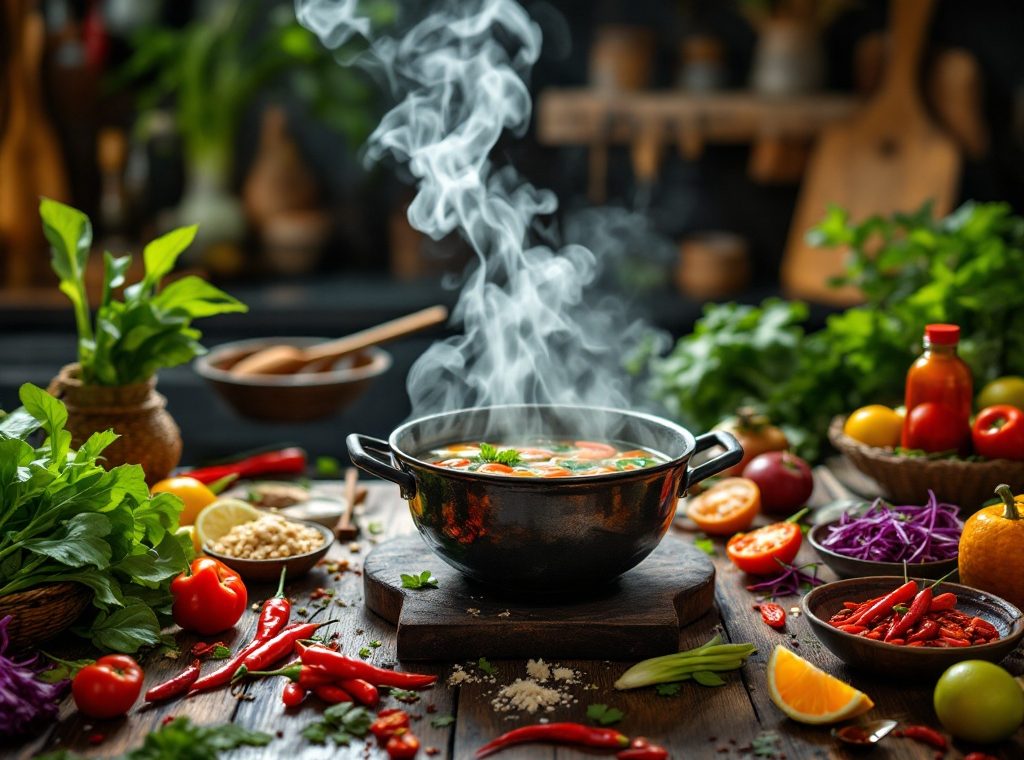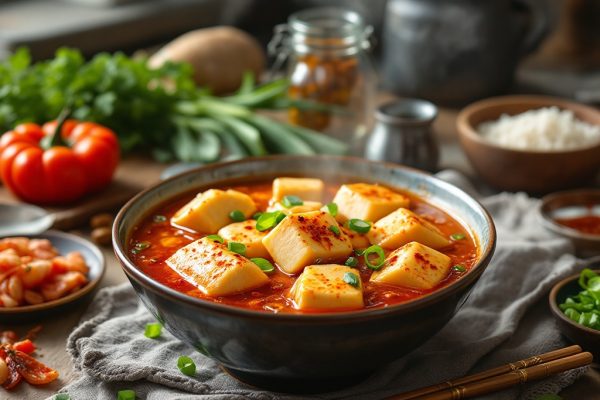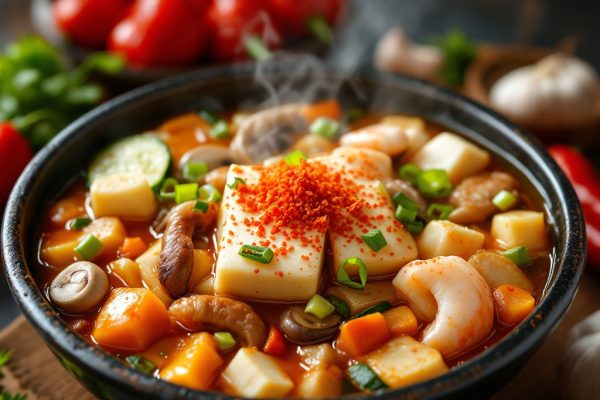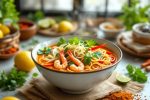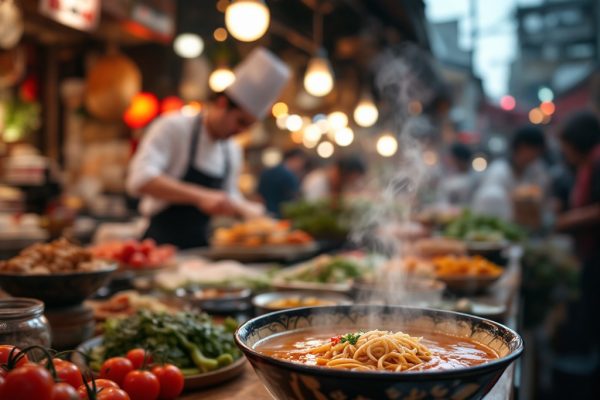Secrets of Cuisine of Thai People: Vegetables, Broths, and More
Unlock the secrets of authentic Thai cuisine! Discover the delicate balance of sweet, sour, salty, spicy, and bitter flavors achieved through key ingredients like fish sauce, lime juice, and chilies. Explore the health benefits of fresh vegetables like morning glory and bok choy, and learn how traditional cooking techniques like stir-frying and steaming enhance the vibrant flavors. From flavorful curries to iconic soups like Tom Yum, dive into the rich world of Thai cooking and elevate your culinary skills. Read on to embark on a delicious adventure!
Important information

- Thai cuisine balances five flavors: sweet, sour, salty, spicy, and bitter, using key ingredients like fish sauce, lime juice, palm sugar, and chilies.
- Fresh herbs and spices such as lemongrass, galangal, and kaffir lime leaves add depth and complexity to Thai dishes.
- A variety of vegetables, including morning glory, bok choy, and Thai eggplant, contribute to the cuisine’s nutritional value and unique textures.
- Aromatic broths, often made with chicken or pork bones and infused with herbs like lemongrass and galangal, form the base of many Thai soups.
- Common Thai cooking techniques include stir-frying, steaming, and deep-frying, which enhance the fresh flavors and textures of the ingredients.
Understanding the Secrets of Thai Cuisine
Thai food is a delicate dance of five fundamental flavors: sweet, sour, salty, spicy, and bitter. This harmonious balance is achieved through a masterful blend of ingredients like fish sauce, lime juice, palm sugar, and chilies. Fresh herbs and spices, such as lemongrass, galangal, and kaffir lime leaves, further enrich the dishes, adding layers of complexity. Regional variations abound, influenced by neighboring countries and the availability of local ingredients. By understanding these elements, you can unlock the secrets of Thai cooking and truly appreciate its intricate and nuanced flavors.
The Role of Key Ingredients
Thai cuisine’s signature flavors and textures come from a few key ingredients. Understanding their roles simplifies cooking, much like having building blocks. A well-stocked pantry with these essentials allows you to create a variety of dishes, streamlining your exploration of Thai cuisine. You needn’t buy everything at once; focus on the core components first. This approachable method demystifies Thai cooking, making it less daunting as you build your skills and flavor palate.
Balancing Flavors: Sweet, Sour, Salty, Bitter, and Spicy
Thai food is a delicate balancing act, a flavorful symphony of five key tastes: sweet, sour, salty, bitter, and spicy. Fish sauce provides the salt, lime juice the tangy sourness, and palm sugar a touch of sweetness, while chilies bring the heat. Herbs and vegetables contribute bitter notes, rounding out the complex flavor profile that makes Thai cuisine so unique. Each bite is an explosion of taste, a harmonious blend of contrasting flavors. The sweetness of palm sugar, for instance, beautifully offsets the fiery chili, creating a truly delicious and multi-layered experience.
Exploring Thai Vegetables and Their Health Benefits
Fresh vegetables are essential to Thai cuisine, contributing flavor, texture, and vital nutrients for good digestion and overall health. Aromatic herbs like Thai basil, cilantro, and lemongrass, along with zesty galangal, kaffir lime leaves, and chilies, create the cuisine’s signature freshness. Familiar vegetables such as eggplant, cabbage, carrots, and green beans frequently appear in stir-fries and curries. The unique crunch of morning glory and bamboo shoots adds another layer of texture, enhancing the dishes’ natural flavors and refreshing qualities. Fiber-rich vegetables are key for healthy digestion. Bok choy, water spinach, and yardlong beans are excellent examples, often lightly cooked to preserve nutrients and crispness. Thai cuisine also embraces more exotic vegetables. Various eggplants, in shades of green, purple, and white, add depth and complexity. Long beans are another staple in stir-fries and curries, while pea eggplants contribute their own distinct flavor.
Fresh Vegetables: Essential for Digestion
Fresh vegetables, packed with fiber, are crucial for healthy digestion. Fiber promotes regular bowel movements and prevents constipation, while nourishing beneficial gut bacteria, contributing to a healthy gut microbiome. Thai cuisine embraces this principle, often showcasing morning glory, bok choy, and other greens. Lightly cooked or served fresh, these vegetables retain their nutrients, enhancing the health benefits of Thai food. Their fiber aids digestion, and they also provide essential vitamins and minerals. Savor the fresh flavors and boost your well-being.
Exotic Varieties: Thai Eggplants, Long Beans, and More
Thai eggplants come in various colors, from green and white to deep purple. Their shapes and sizes are diverse, making them suitable for curries, stir-fries, and salads. Similarly, long beans, also known as yardlong beans, add a crisp texture and subtle flavor to these dishes. Thai cuisine also includes more exotic vegetables.
Winged beans
Pea eggplants
A variety of gourds
These unique ingredients offer distinct flavors and textures, showcasing the diversity of Thai cooking.
Mastering Thai Broths and Soups
Thai bone broth, typically made with chicken or pork bones, simmers with fragrant herbs and spices like lemongrass, galangal, and kaffir lime leaves to create a light and aromatic base. This flavorful broth forms the foundation of iconic Thai soups such as Tom Yum and Tom Kha. Its delicate taste intensifies with additions like fish sauce, lime juice, chilies, and coconut milk, resulting in rich and complex flavor profiles. Beyond their culinary appeal, Thai broths often incorporate ingredients like galangal, known for its anti-inflammatory properties, and lemongrass, which may aid digestion, enhancing both taste and potential health benefits.
Characteristics of Thai Bone Broth
Simmering Thai bone broth for one to four hours with traditional vegetables, herbs, and seasonings creates a flavor distinctly different from Western broths.
Creating a Base for Complex Thai Soups
Thai cuisine is renowned for its flavorful and aromatic broths. These broths create a complex and fragrant base, using aromatic herbs and spices such as lemongrass and galangal. This foundation is essential for iconic soups like Tom Yum and Tom Kha, which are staples of Thai cooking.
Using Herbs and Ingredients for Health Benefits
Thai cuisine offers a flavorful and healthy dining experience. Lemongrass, galangal, and kaffir lime leaves are just a few of the herbs that give Thai food its distinctive character. Lemongrass aids digestion, galangal boasts anti-inflammatory properties, and kaffir lime leaves are packed with antioxidants. These aromatic ingredients frequently enhance Thai soups and broths.
Traditional Thai Cooking Techniques
Thai cooking emphasizes fresh ingredients and vibrant flavors. Essential techniques include:
- Stir-frying, for quick, flavorful results.
- Steaming, to gently preserve nutrients and texture.
- Deep-frying, to achieve a satisfying crispness.
Combined with an array of aromatic herbs and spices, these methods create signature dishes, from fragrant curries to flavorful stir-fries, offering a truly delicious culinary adventure.
Secrets to Stir-frying and Steaming
Stir-frying uses high heat and constant motion to preserve fresh flavors and develop complex ones. This technique helps to create dishes with vibrant tastes and textures.
Steaming gently cooks food with steam, locking in nutrients and highlighting natural tastes. This method is ideal for preserving the nutritional value and delicate flavors of fresh ingredients.
Both techniques emphasize fresh ingredients, a key element of Thai cuisine.

